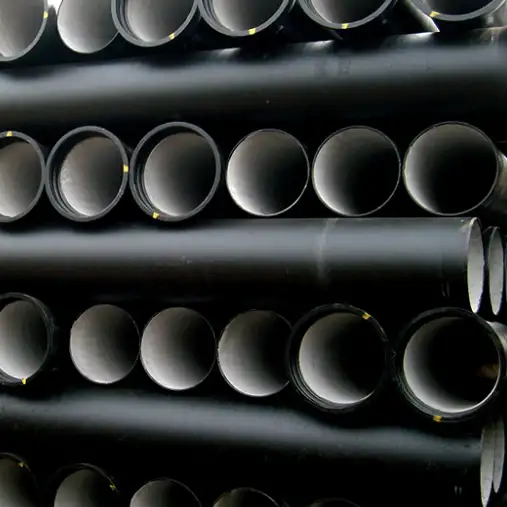Cast iron and ductile iron pipes are both widely used in water and sewage systems, but their material properties and performance differ significantly. Cast iron pipe, made from brittle gray iron with flake graphite, has been a traditional choice for decades, while ductile iron pipe (DIP), engineered with nodular graphite for enhanced flexibility, dominates modern infrastructure. This article compares their strength, corrosion resistance, pressure ratings, and costs, backed by ASTM/AWWA standards.

1. Introduction
The selection of piping materials is crucial in infrastructure projects, influencing factors like durability, cost, and maintenance. Cast iron and ductile iron pipes have been staples in various applications, from residential plumbing to large-scale municipal systems. Understanding their differences is essential for making informed decisions.
2. Material Composition and Metallurgical Differences
Cast Iron
Cast iron, primarily gray cast iron, is composed of approximately 96-98% iron, 2-4% carbon, and small amounts of silicon. The carbon in cast iron forms as graphite flakes, which contribute to its characteristic brittleness.
Ductile Iron
Ductile iron, also known as nodular cast iron, is produced by adding small amounts of magnesium to molten iron. This addition causes the graphite to form as spherical nodules, enhancing the material’s ductility and toughness.
3. Mechanical Properties Comparison
| Property | Cast Iron | Ductile Iron |
|---|---|---|
| Tensile Strength | Lower | Higher |
| Yield Strength | Lower | Higher |
| Elongation at Break | Lower | Higher |
| Impact Resistance | Poor | Excellent |
| Hardness | Higher | Moderate |
Ductile iron’s superior mechanical properties make it more suitable for applications subjected to dynamic loads and stresses.
4. Corrosion Resistance and Longevity
Cast Iron
While cast iron has inherent corrosion resistance, it is more susceptible to environmental factors, leading to deterioration over time, especially in underground applications.
Ductile Iron
Ductile iron offers enhanced corrosion resistance, particularly when coated or lined with protective materials, extending its service life in various environments.
5. Installation and Handling Considerations
Cast Iron
Due to its brittleness and weight, cast iron pipes require careful handling during installation to prevent damage. Specialized equipment may be necessary for lifting and positioning.
Ductile Iron
Ductile iron’s increased toughness allows for easier handling and installation. Its flexibility can accommodate ground movements, reducing the risk of damage during seismic events.
6. Cost Analysis and Economic Implications
| Aspect | Cast Iron | Ductile Iron |
|---|---|---|
| Material Cost | Lower | Higher |
| Installation Cost | Higher | Moderate |
| Maintenance Cost | Higher over time | Lower over time |
| Lifespan | Shorter | Longer |
While ductile iron has a higher initial cost, its durability and lower maintenance requirements can result in cost savings over the long term.
7. Environmental Impact and Sustainability
Ductile iron’s longer lifespan and recyclability contribute to its environmental sustainability. Cast iron, while recyclable, may require more frequent replacements, leading to higher resource consumption.
8. Applications in Modern Infrastructure
Cast Iron
-
Historical buildings and structures
-
Decorative elements and architectural features
-
Certain municipal applications where flexibility is less critical
Ductile Iron
-
Water and wastewater pipelines
-
Stormwater systems
-
Industrial applications requiring high strength and durability
9. Maintenance and Repair Practices
Regular inspection and maintenance are essential for both materials. Ductile iron’s resistance to cracking simplifies repair processes, while cast iron may require more frequent interventions.
10. Future Trends and Innovations
Advancements in coating technologies and materials science continue to improve the performance and longevity of both cast and ductile iron pipes, expanding their applicability in modern infrastructure projects.
11. Frequently Asked Questions (FAQs)
1. What is the primary difference between cast iron and ductile iron?
The primary difference lies in their microstructure. Cast iron has graphite flakes, making it brittle, while ductile iron has spherical graphite nodules, enhancing its ductility and toughness.
2. Why is ductile iron preferred over cast iron in modern applications?
Ductile iron’s superior mechanical properties, such as higher tensile and yield strength, make it more suitable for applications subjected to dynamic loads and stresses.
3. How does corrosion affect cast iron pipes?
Corrosion can lead to the deterioration of cast iron pipes, causing leaks and failures, especially in underground applications where environmental factors accelerate the process.
4. Are ductile iron pipes more expensive than cast iron pipes?
Yes, ductile iron pipes have a higher initial material cost. However, their durability and lower maintenance requirements can result in cost savings over time.
5. Can cast iron pipes be used in modern infrastructure projects?
While cast iron pipes are still in use, ductile iron’s enhanced properties make it a more reliable choice for new installations, particularly in demanding applications.
6. What are the environmental benefits of using ductile iron?
Ductile iron’s longer lifespan reduces the frequency of replacements, conserving resources and minimizing environmental impact. Additionally, both materials are recyclable, contributing to sustainability.
Conclusion
Both cast iron and ductile iron pipes have their places in infrastructure projects. However, the advancements in material science and engineering have made ductile iron the preferred choice for many modern applications due to its superior mechanical properties, corrosion resistance, and overall durability. When selecting piping materials, it’s essential to consider the specific requirements of the project, including load conditions, environmental factors, and budget constraints.

